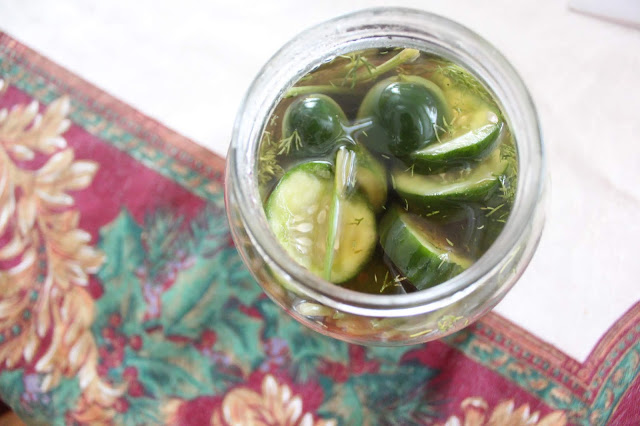Anybody up for some zero waste pickles? This easy homemade dill pickle recipe requires no canning what so ever. Just a refrigerator, some ingredients from the farmers market, and a little patience. Once you have the cucumbers set up in the jar (which takes barely 15 minutes), you just have to wait three to four days for the pickling to begin. Trust me when I say these are worth the wait: My batch came out absolutely delicious, crunchy and sooo drool worthy. Way better than any store bought pickles, that’s for sure. And no added artificial ingredients!
Recently, I went to the farmers market and bought some dill. The only problem was they didn’t have any kirby cucumbers (they’re perfect for pickling)! I had to wait a whole week before buying the cucumbers, but that’s okay. The dill stayed fresh, amazingly. The only other ingredients I needed to make this batch was salt, garlic and red pepper flakes. I got the garlic from the farmers market as well, but everything else I already had at home. I’ve been meaning to make my own zero waste pickles ever since joining the zero waste community, honestly. Pickles go really quick in my house because my father and I both love them, especially dill pickles. Making my own saves money and I was actually able to make two jars of pickles instead of just one! Plus, I can actually re-use the brine to make more pickles…so what’s there not to love?
Pickles are also a great way to stop food waste in its tracks. I’ve made pickles from cucumbers that were on their way out and boy do they taste amazing. So if you want to stop dishing out money on pickles, and make your own, you’ve come to the right place. Here’s how to make homemade dill pickles.
_________________________
Zero Waste Pickles
Homemade Dill Pickles
 |
| Day of packing: Cucumbers still a vibrant green. |
Ingredients:
- 6 – 8 kirby cucumbers (chopped/sliced the way you want)
- 1 bushel of fresh dill
- 4 cups of water
- 3 tablespoons of salt
- 6 – 8 cloves of garlic (I used 4 per jar)
- Sprinkle of red pepper flakes
- Pinch of black pepper
 |
| Two weeks after packing: Left jar is completely empty of pickles (they were all eaten). Only a few pickles remain in right jar. Color is clearly changed, brine much more murky. |
Directions:
- Clean out two glass jars salvaged from being recycled, or mason jars you have on hand. Set them aside.
- In a bowl or pot, mix the water with the salt using a wooden spoon to make the brine. Mix until the salt fully dissolves. You do not need to heat up the brine on the stove at any point to do this. Set it aside.
- Next, put some black pepper, garlic cloves, dill and red pepper flakes at the bottom of each jar. I literally separated the bushel of dill and stuffed half in each jar. I stuffed it in, stems and all, pushing it down as much as it would go. Make sure to peel the garlic cloves first and save any garlic peels for zero waste vegetable broth.
- Then, cut up your pickles the way you’d like them (I chopped them, but you can slice them into spears if you want). I honestly didn’t have much room to work with, so chopping them the way I did worked perfectly. Stuff them into the jar.
- Last but not least, pour the brine over the ingredients you just added to both jars. If you need to make more brine, just double the amount of salt and water you use. It all depends how many jars of pickles you’re looking to make. Be sure to cover the pickles as best you can with the brine, then seal it up. Place the jars into the refrigerator.
- Within three to four days, you can begin taste testing them (day zero being the day you packed them). Make sure to burp them daily to release any built up dioxide. They should change in color and the brine should get a little cloudy as the days pass.
These pickles came out so delicious and so crunchy! After about four days they were ready. They’ve been keeping very well and will last for months in the fridge. You can use the brine to pickle another batch of cucumbers too, if you’d like. Some people like to drink it straight up, but I’m not one for that. But hey, whatever floats your boat.
I’ve also made zero waste beet pickles before. Those were super tasty too, and just as easy to make.
Would you give this zero waste pickle recipe a try? Have you ever tried making your own dill pickles? Leave a comment below to let me know.




Amazing dill pickles recipe. Thanks for sharing such an awesome recipe.
Really nice post. Thank you for sharing amazing information.
Best Makeup Artist in Gurgaon
Makeup Academy in Gurgaon